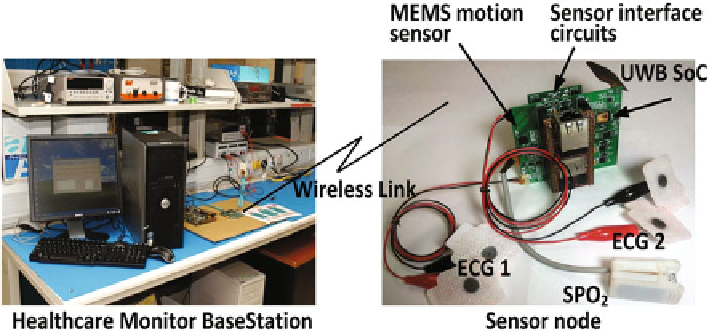Biomedical Engineering Reference
In-Depth Information
Fig. 23
Picture of wireless sensor node and base station
presents the BER of receiver in high gain modes. The receiver achieves a maximum
sensitivity of
10
−
3
. For surface insu-
lation resistance (SIR) measurement, another signal generator generates the single
tone NBI signal, it is combined with TX data by a wideband balun and fed into
the input of receiver. In this measurement, the receiver is first set in the maximum
gain mode, and the RX input power is maintained at the level of 10
−
6
BER. Then
the interference signal is introduced, its power is increased gradually until the RX
BER is degraded to 10
−
2
. The interference signal frequency is swept from 2.0 to
5.5 GHz to test system's performance under in-band/out-band interferences. The
receiver (SIR) performance is measured as shown in Fig.
22
b. The measured highest
in-band/out-of-band SIR is
−
92 dBm at a data rate of 1 Mb/s with BER
=
−
−
47 dB respectively.
The transceiver performance has also been summarized and compared with other
state-of-the-art IR-UWB transceivers in Table
1
. As shown, our work achieved the
highest TX output swing and highest RX sensitivity when normalized to same data
rate (1 Mb/s). It also achieved competitive interference mitigation capabilities and
provides the added benefit of low system complexity and scalability.
A prototype multichannel vital signal monitoring system has been developed. As
shown in Fig.
23
, it includes two channels of ECG, one channel of SpO
2
, and one
channel three-axis motion sensing using microelectromechanical systems (MEMS)
accelerometers. Off-the-shelf components are used to construct the sensor readout
circuits. The analog signal is digitized at a sampling rate of 1 kHz with 12-bit reso-
lution. A disposable button cell battery (CR2032) is used to power the entire sensor
node. The acquired ECG/SpO
2
/motion data are transmitted by the sensor node and
received by the personal healthcare server for recording and display. The recorded
data for a person in motion is shown in Fig.
24
. Measurement shows the communica-
tion distance is longer than 10 m which is suitable for the in-door health monitoring
applications.
33 and

Search WWH ::

Custom Search